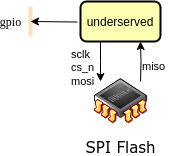654 ITS-RISCV
654 : ITS-RISCV

- Author: Bambang T. Wibowo, Chazim Fikri A., Hernanda A. P., M. Hafidzh, Figo A. M., and Faiz S. K.
- Description: ITS RISC V based on the underserved TinyTapeout 07.
- GitHub repository
- Open in 3D viewer
- Clock: 20000000 Hz
How it works
When the system boots up, it will start accessing the SPI bus to set up a connected SPI Flash memory in XIP mode and start executing instructions from there. The GPIO can be used to output data, e.g. as a bitbanged UART.

How to test
The testbench contains a model of an SPI Flash. A program in Verilog Hex format can be preloaded into the Flash model.
Underserved can easiest be run locally using FuseSoC.
Install FuseSoC
pip install fusesoc
Create and enter a new workspace
mkdir workspace && cd workspace
Register underserved as a library in the workspace
fusesoc library add underserved /path/to/prince
...if repo is available locally or... ...to get the upstream repo
fusesoc library add underserved https://github.com/olofk/underserved
Show available cores in workspace (probally just underserved for now if you haven't added other libraries)
fusesoc core list
Show info about underserved
fusesoc core show underserved
Run linting (static code checks) using Verilator
fusesoc run --target=lint underserved
Run underserved testbench
fusesoc run --target=sim underserved
Run with modelsim instead of default tool (icarus)
fusesoc run --target=sim underserved --tool=modelsim
External hardware
Expects a compatible SPI Flash. The XIP controller was stolen from PicoSoC which also contains some info about compatible SPI Flash components.
IO
| # | Input | Output | Bidirectional |
|---|---|---|---|
| 0 | gpio0 | ||
| 1 | gpio1 | ||
| 2 | gpio2 | ||
| 3 | gpio3 | ||
| 4 | gpio4 | ||
| 5 | sclk | ||
| 6 | cs_n | ||
| 7 | mosi | miso |